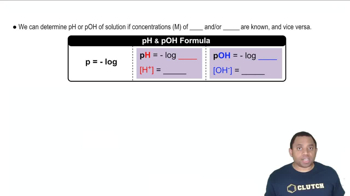Determine whether each anion is basic or neutral. For those anions that are basic, write an equation that shows how the anion acts as a base. a. C7H5O2– b. I– d. F–
Ch.16 - Acids and Bases

Chapter 16, Problem 98
Determine the [OH-] and pH of a solution that is 0.250 M in HCO3⁻.
 Verified step by step guidance
Verified step by step guidance1
Identify the relevant equilibrium reaction for bicarbonate ion (HCO₃⁻) in water: HCO₃⁻ + H₂O ⇌ H₂CO₃ + OH⁻.
Write the expression for the equilibrium constant (K_b) for the reaction: K_b = [H₂CO₃][OH⁻]/[HCO₃⁻].
Use the relationship between K_w, K_a, and K_b to find K_b for HCO₃⁻: K_b = K_w / K_a, where K_w is the ion-product constant of water (1.0 x 10⁻¹⁴) and K_a is the acid dissociation constant for H₂CO₃.
Set up an ICE (Initial, Change, Equilibrium) table to determine the changes in concentration of HCO₃⁻, H₂CO₃, and OH⁻ at equilibrium.
Solve for [OH⁻] using the K_b expression and the values from the ICE table, then calculate pH using the relationship pH + pOH = 14.
Key Concepts
Here are the essential concepts you must grasp in order to answer the question correctly.
Bicarbonate Ion (HCO3⁻)
The bicarbonate ion (HCO3⁻) is a key component in the bicarbonate buffer system, which helps maintain pH in biological systems. It acts as a weak base, capable of accepting protons (H⁺) to form carbonic acid (H2CO3), thus influencing the acidity of the solution. Understanding its role is crucial for calculating hydroxide ion concentration and pH.
Recommended video:
Guided course

Ion Formation
pH and pOH Relationship
pH is a measure of the hydrogen ion concentration in a solution, while pOH measures the hydroxide ion concentration. They are related by the equation pH + pOH = 14 at 25°C. This relationship is essential for determining the pH of a solution when the concentration of hydroxide ions is known, or vice versa.
Recommended video:
Guided course

pH and pOH Calculations
Equilibrium and Acid-Base Reactions
Acid-base reactions often reach a state of equilibrium, where the rates of the forward and reverse reactions are equal. In the case of bicarbonate, it can act as both an acid and a base, depending on the conditions. Understanding how to set up and solve equilibrium expressions, such as the dissociation of HCO3⁻, is vital for calculating [OH⁻] and pH.
Recommended video:
Guided course

Acid-Base Reaction
Related Practice
Textbook Question
Textbook Question
Determine whether each anion is basic or neutral. For those anions that are basic, write an equation that shows how the anion acts as a base. c. NO3–
Textbook Question
Determine the [OH–] and pH of a solution that is 0.140 M in F–.
Textbook Question
Determine whether each cation is acidic or pH-neutral. For those cations that are acidic, write an equation that shows how the cation acts as an acid. a. NH4+
Textbook Question
Determine whether each cation is acidic or pH-neutral. For those cations that are acidic, write an equation that shows how the cation acts as an acid. b. Na+
Textbook Question
Determine whether each cation is acidic or pH-neutral. For those cations that are acidic, write an equation that shows how the cation acts as an acid. c. Co3+
